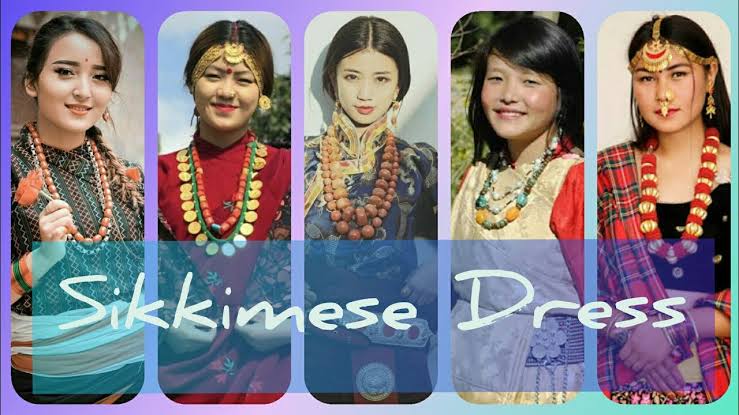My dear visitors, Have you ever heard about traditional dress of Sikkim? Sikkim, one of the states of North Eastern India is a beautiful state showcasing a lot of multi-ethnic groups. Eye-catching landscape views, tranquility, variety tastes, vibrant outfits, a rich and mesmerizing culture, and last but not least, gracefual dance forms, of course! So Sikkim has a lot to offer.
Still being a small state, it showcases the variation of culture and diversifies the communities by their own clothing styles and fashion sense. The outfits adorned by the people not only showcase their traditions but also their social status and religious beliefs.

Traditional Dress of Sikkim For Men:
Bakhu, often spelled “Kho,” is the traditional garment of Sikkim and is worn by both men and women.It’s a long, billowy garment that fastens at the neck but is cinched in the middle with a belt of silk and cotton. Bakhu is very similar to the Tibetan Chuba, except for the fact that it is sleeveless.
Over the years as western culture’s influence has grown in the country, women have started wearing it with a pair of jeans to add a western twist to the traditional look.
Bhutia Tribe:-
The outfits worn by people belonging to the Bhutia tribe are very similar to Tibetan outfit (known as Tibetan Chuba).
Thokro Dum:-
The people of the Lepcha tribe are noted for the elaborate traditional clothing they wear, renowned as Thokro Dum.
Thokro Dum is paired with a cap which is known as Shamo and a Yenthatse which is a traditional Lepcha shirt. They also wear cone-shaped bamboo and rattan hats at weddings and as well as festive seasons and religious occasions.
To make these hats, skilled artisans use fine canes made from bamboo, straws, & leaves. To finish the outfit, waist belt called Dupra is placed at one shoulder and wrapped around the waist. During the Chogyal dynasty’s reign, royal soldiers used like as a traditional headpiece Thyaktuk too.
Shuruval
This attire is worn by Nepalese males in Sikkim. A trouser is worn with a long double-breasted coat that reaches a little below the waist. Shuruval is the name of the bottom, and Daura is the name of the shirt.
The Shuruval is complemented by a waistcoat, Askot, and a belt, Patuki. They also have the Khukri; a hefty weapon placed in a leather case (Daab).
Sikkim Women Traditional Dress

Socially Sikkim peoples are equivalent to Tibetan and Bhutanese.
Both males and females of Bhutia Tribe are different in design, female dress consists of a silky full sleeve loose blouse called as Hanju, a jacket called as Kushen, a different pattern of the cap called as Shambo and shoe called as Shabchu. They also wear it with shawls, known as Majetro, and elegant blouse patterns like Chaubandi Cholo and Tharo Cholo.
Dumvum
The traditional Lepcha clothing worn by ladies in Sikkim is created from a delicate fabric that exudes a refined femininity.
Beautiful sarees called Dumvums or Dumyams in the native language of Sikkim are worn by women of the Lepcha people. A Nyamrek and Taro belt, as well as a cap, are worn to complete the outfit. The head is frequently covered with a Gorey scarf. It enhances a woman’s beauty and symbolizes her honor and pride.
Pharia
The traditional dress known as Pharia, which enhances the beauty of Nepalese women, comes in a range of colors.
The Bhutias wear a long, comfortable-fit shirt that is knotted on four sides. Hence, it is known as Chaubandi Cholo. The upper body is neatly covered in a piece of cloth known as Hembari available in stunning designs for added coverage.
Cultural Ornaments worn by Sikkim Women:-
Women are mostly seen wearing traditional jewelry with their cultural clothing at festivals and weddings.
Lepcha
Women can be seen wearing traditional jewelry such as the Lyak (necklace), Namchok (ear-ring), and Gyar (necklace) at festivals and other occasions (bracelet). The most common metals utilized in their creation are silver and gold.
Bhutia
Bhutia women wear Yencho (earring), Khalli (thick silver-coated anklets), and Joko (ring), Khao (necklace), Phiru (pearl ornament), and Diu (gold bangle), . They are well-known for their fondness for gold, particularly genuine 24-carat gold.
Nepalese
Sir-Bandi (tiara), a jeweled head-ornament, Kantha (necklace), Naugeri (pearl necklace), and Charanihari, yet another necklace, are the ornaments that give Nepalese ladies a lovely appearance.
Check for more updates like shopping these garments and ornaments :- https://1001things.org/mg-marg-gangtok/
Check our blogs:- The Historic Ayodhya Ram Mandir Construction: A Landmark Moment in 2024
Conclusion
The Sikkimese clothing and jewelry are a great blend of culture, diversity, contentment, and, of course, elegance. The goal was to enhance your interest in Sikkim’s rich cultural heritage by explaining the traditional garments and ornaments in the hopes that you’ll make a point of visiting this place.
FAQS :-
1.What is the name of the wedding dress in Sikkim?
Sikkimese wedding dress is very similar to what their royalty wears and is called a ‘bakhu’. A ‘bakhu’ is made out of the finest silk and is worn in a rather traditional, yet distinct way.
2.What is the traditional dress of lepcha?
Dumpra (also dumprá; Lepcha for “male dress”) is the traditional dress of Lepcha men.
3.What is the traditional dress of Sikkim male and female?
The Bakhu is the most common traditional Sikkim dress worn by men and women.
4.What is Lepcha culture of Sikkim?
Lepchas are Mongoloid tribe. Their language is an admixture of Nepalees and Sikkims languages, which is very familiar with Indo-Chinese language.
5.What is culture of Sikkim?
The people of Sikkim are warm, simple and friendly with a nature gaiety with a multi-ethnic twist.
6.What is Sikkim famous for?
Sikkim is famous for its biodiversity, including alpine and subtropical climates, as well as being a host to Kangchenjunga, the highest peak in India and third highest on Earth. Sikkim’s capital and largest city is Gangtok.

